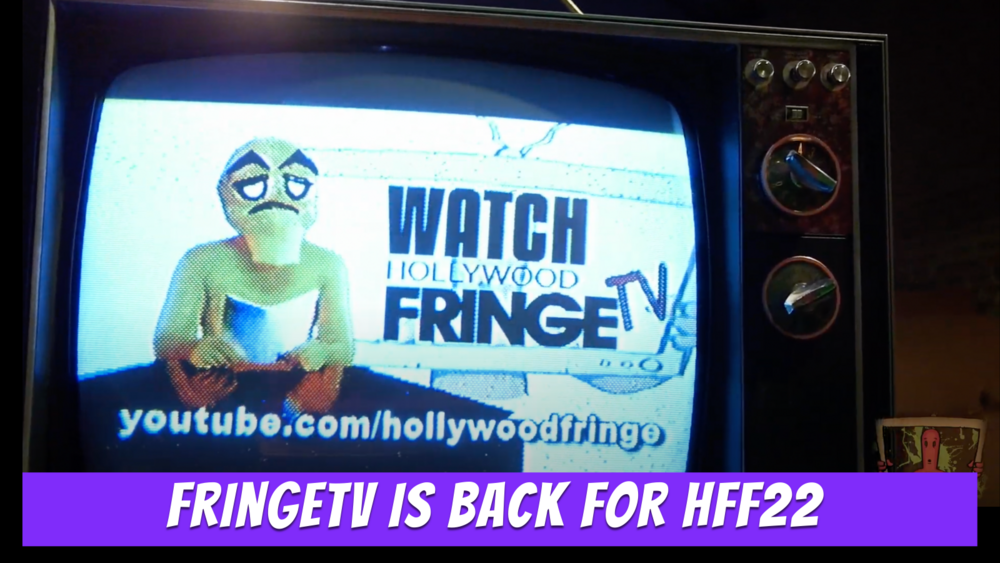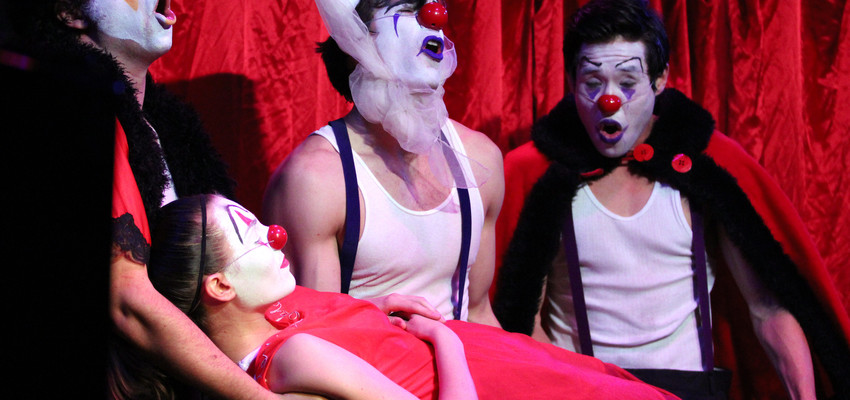recent articles
our guide to choosing your show category
4 days agobusking 101: busking on hollywood
about 1 month agoartist marketing opportunities
10 days agofringe central hours + event schedule
10 days agonow hiring social media intern!
10 days agoyour fringe show & tech
10 days agorecapping the marketing & ticketing workshop!
17 days agocanva is your friend!
29 days agoannouncing the 2024 artist fund recipients!
about 1 month agohff24 workshop #4: antiracism for white artists
about 1 month ago
4
MAY 2022
FRINGE TV
PARTICIPANT LIGHTNING ROUND
(Festival Covid Guidelines will be followed at this event)
We invite you to join us on Monday, May 16th from 5 pm – 8 pm for a Lightning Round of FringeTV interviews. It will be held at Thymele Atlas (1100 N. Western, Los Angeles).
You will answer 2 questions very, very quickly. Lightning round style! Remember, you will be in a short video with 30 other productions, so make your answers SHORT & SWEET! Make sure to bring your awesome personality and character to the stage for us! You are welcome to wear your costumes and be as animated as you would like.
You will answer the following questions:
What is your show about?
What is your favorite line in the show?
No more than four people from your production are allowed in the video. We recommend planning ahead for who will say what, and when. Remember: keep it short. If your answers are too long, your show may not make the cut.
See past Lightning Round answers here!
To sign up please fill out this form.
FRINGE TRAILERS
We want your show trailers! We will be featuring #HFF22 show trailers on our website this year. A great way to pique the interest of potential ticket buyers. To be included in this theatrical flight board, submit your registered show’s trailer by filling out this form.
Submit your trailer by May 15th to be included in this promotional opportunity!
Email questions to [email protected]

FRINGE RUNWAY
Showcase select costumes from your production at Fringe Runway, the Hollywood Fringe fashion show on Wednesday, June 1st at Three Clubs.
Any Hollywood Fringe Production may enter by filling out this form. The deadline to enter Fringe Runway is is Sunday, May 29th before midnight (a.k.a. 11:59 pm).
30 productions will be chosen by random lottery to participate in the event.
Guest judges will review each look and award prizes to three favorites.
Get full details here. We’ll see you on the runway!
SHOW SPONSORED DRINKS- SOLD OUT
The sponsored drink program is back for its tenth year, allowing you to feature a drink crafted especially for you at the infamous Bryan’s Bar at Fringe Central (905 Cole Ave). For $100, you provide the name, your base alcohol choice, and details about your show, business, etc, and our in-house mixologist will create a handcrafted beverage to uniquely promote you, your business, and/or production! You will also receive an official #hff22 social media blast, blog post, a newsletter shout-out, and printed signage at the bar. All proceeds from sponsored drink sales go to the Fringe.
To take advantage of this boozy marketing opportunity please submit this form by May 25th! Drinks are scheduled on a first come first served basis so submit soon, we only have space for 16 special drinks this year!
Email [email protected] with any questions.
We look forward to marketing your show at HFF22!
FRINGE CABARET
Fringe Cabaret is now booking fun acts that include variety, magic, dance, music, comedy, and general silliness! Cabaret will be presented at the Atlas Theater located inside Thymele Arts (1100 N. Western, Los Angeles 90029). Booking acts for June 2nd, 6th, 9th, and 14th. Fill out this form to submit your show! Sign up soon as spots tend to fill up quickly.
Want to attend Cabaret and support your fellow Fringers? Check out all the details and get tickets!
Hard-hitting dramatic material is not the best to present on the Cabaret Stage, however, you can still promote your show through us by donating free show tickets or swag to be raffled off during Cabaret performances. To arrange a donation, contact [email protected]

20
APR 2022
Great news! We will be offering three $500 stipends to HFF22 producers from money raised from our Fringe Memberships campaign!
Artist Fund Applications are now open!
Artist Fund applications are now open! $500 artist fund stipends are available to currently registered local HFF22 producers whose income has been substantially impacted by the COVID-19 pandemic.
—->Applicants do not have to be first-time producers
—->It is recommended that applicants identify as low income (making under $66,250 annually)
—->Primary applicants must primarily reside in Southern California
—->Those who have received other HFF program stipends (scholarship stipend or artist fund via the Fringe, etc) in 2021 or 2022 are not eligible
Applications close Friday, April 29th at 9:59 PM. Apply here today!
Want to help more artists get $$ at Fringe??
We don’t have to leave it at only three stipends. If we raise another $2000 in Memberships (which can be one time donations or recurring monthly donations!), we can fund a whole additional stipend. Let’s do some math…that’s twenty memberships at the Fringe Fan level ($100), eight at the Fringe Friend level ($250), four at the Fringe Family level ($500), or two at the Fringe Freak level ($1,000).
Will you help us get there? Please read all about our Membership Program here and consider donating today. Not only will you be helping our artists and programs like Fringe Central, you’ll also get a ticket to our Opening Night Party (and more)!
21
MAR 2022
After numerous conversations and intense deliberation by our selection committee, faced with an incredibly difficult choice over many qualified applications for this award, we are proud to announce our Fringe Scholarship winners!
The Winners of the 2022 Fringe Scholarships are:
A Terrible Show for Terrible People
Lvl 1 Gygax and Of Branch, Of Beast, Of Beatnik
Terraforming Marginalized Voices
The Ramón Show: Spiritual Cheerleading 101
Yellow/Blue
With so many outstanding applications we would like to highlight 3 shows that stood out to our committee as honorable mentions:
Love Chicken
Teaching a Robot to Love
Sorta Kinda
Congratulations to all!
As an open-access festival, we seek to foster a ground-breaking community of artists and make performances more accessible, both to the artists who produce them and for those who otherwise cannot afford to see theatre. Our committee firmly believes that these productions will enrich audience experience and the quality of the Hollywood Fringe Festival’s artistic offerings through the presentation of unique and underrepresented themes.
Each scholarship recipient will receive free registration and a $550 stipend towards production costs, a Fringe mentor, and marketing and networking opportunities as a member of the Fringe community. Fringe Scholarships are available to first-time Hollywood Fringe producers who contribute to the ethnic, cultural, racial, intellectually or physically disabled, d/Deaf, and the LGBTQ+ diversity of the Fringe community.

7
MAR 2022
Pre-Festival Event Safety Breakdown
To keep our community safe, we have the following COVID requirements in place for our pre-Festival events.
It’s a FREAKin’ Fundraiser
Wednesday, March 23
Due to the nature of this event (live band karaoke, food & drink indoors and movable seating), we are requiring a negative test from all attendees. Although masks will be recommended, they will not be required at this event, especially while performing, eating or drinking. In this venue, attendees will be required to show proof of vaccination against COVID-19 (booster not required but recommended).
Town Hall #2: Prepping for Fringe
Saturday, April 16
This event will follow our artist safety guidelines. In short, this event will require proof of vaccination (booster recommended but not required) or a negative test result within 72 hours of the event (48 hours if antigen test, not PCR). Masks will be required at this event. While cloth masks are acceptable, it is highly encouraged that you wear a medical grade mask (surgical/3-ply, KN95, KF94 and N95 masks).
Office Hours
All of our office hour locations will have different requirements depending on the space’s own guidelines. Please see this blog for a full breakdown.
Our Festival event guidelines will drop with our audience guidelines on April 18, 2022.

27
FEB 2022
The Guide Contest is back! We would like to invite our Fringe community to design the 2022 Hollywood Fringe Festival guide cover, which will be distributed throughout L.A. county. Submit your design ideas anytime between today, Monday, February 28th, and Thursday, March 3rd by 12:00 pm to be included in the qualifying round. To enter the contest visit our contest link.
The winner will receive $959 (approximately $550 after the commission taken by 99Designs). Additionally, the winner is eligible for an additional prize of $1,300 to pull elements from their winning guide design to create the 2022 T-shirt, iPhone app icon, and the official Fringe Button – the pin fringe-goers sport as they see shows around Hollywood. Participation is open to everyone. To get started, create a (free) account on 99Designs.com.
Curious what past branding has looked like? Check out our most recent printed guide & previous design winners!
Digital file of our 2019 printed guide
Know the perfect artist? Please share the contest or this blog post with friends!












